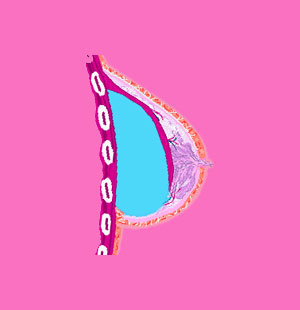
Subpectoral breast implants, also known as dual plane implants, are surgically placed in a modified submuscular/subglandular combination position. Normal full submuscular placement positions the implant completely under the pectoralis muscles, while this modified placement locates the prosthesis partially under the pectoralis major muscle and partially in the subglandular position.
This approach offers a nice compromise between the traditional above or below the muscle placement options and demonstrates realistic appearance and feel in the majority of patients.
Subpectoral Breast Implant Positioning
In this hybrid surgical procedure, the breast implant is placed carefully under the pectoralis muscle, which covers the upper portion of the prosthesis. The remainder of the implant is left free to drop into the subglandular space, behind the organic breast tissue.
This approach offers a natural looking contour in the cleavage, while still allowing the bottom of the breast to drop in a rounded and seemingly un-enhanced shape.
Movement at the bottom of the implant mimics organic breast tissue, since there is no muscular support offered. The top of the implant remains high, concealed and supported by the incredibly strong pectoral muscles.
In essence this placement offers a partial submuscular and partial subglandular approach rolled into one aesthetically pleasing package.
Advantages of Subpectoral Placement
This dual plane approach to breast augmentation has become one of the most popular options in cosmetic breast surgery.
Placement beneath the pectoralis major muscle reduces capsular contracture rate significantly.
The implants look very natural in this position and move very much like perfectly supported real breasts.
The extra organic muscle tissue at the top of the implant blends the shell outline nicely into the body, providing a lifelike teardrop shaped contour.
This placement has a slightly lower displacement rate than traditional full submuscular placement.
Disadvantages of Subpectoral Breast Implants
The main drawback of dual plane positioning is a more involved operation than traditional subglandular placement. This creates a longer and more painful recovery period for the patient.
Some interference with mammography is still reported, since the bottom of the implant does enter the subglandular space, although this is still less than in full subglandular placement.
Some athletic women complain of strange feelings or interactions between the implant shell and the chest muscles, although most women acclimate to the prosthesis with time.
Complication rate is higher than in subglandular placement and some instances of displacement can occur.
Some distortion of the upper implant might occur during vigorous exercise in some women.
Finally, the cost of this procedure is usually more than subglandular placement.
Subpectoral Implant Placement Comparison
This is a terrific approach to breast enlargement, which seems to produce the very best results in the majority of women. The procedure combines the best facets of both over and under the muscle placement and eliminates some of the worse potential complications of each.
Many doctors offer this procedure as their exclusive means of performing breast augmentation, since the results speak for themselves.
If you are interested in learning more about dual plane breast augmentation, talk to your qualified cosmetic surgeon to determine if this procedure can give you the breasts you have always wished for.



